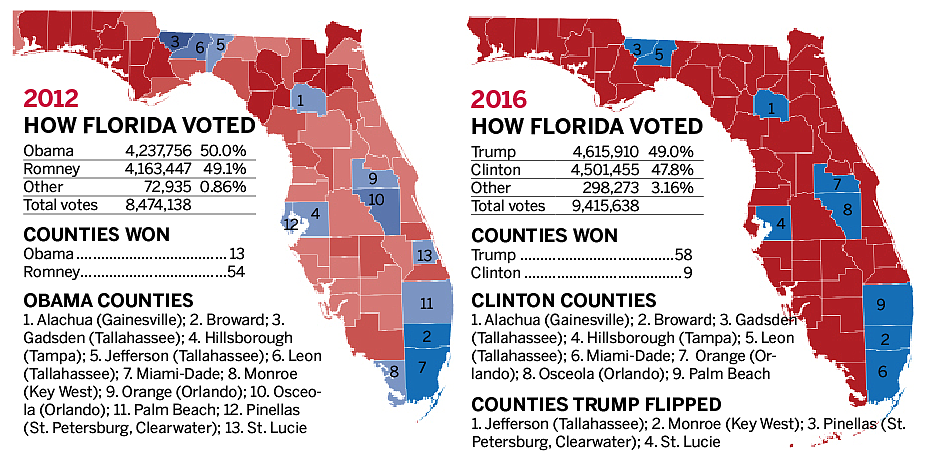- May 23, 2025
-
-
Loading

Loading

The Rust Belt states of Pennsylvania, Wisconsin and Michigan became the story of the Nov. 8 election. But we Floridians know that, had Hillary Clinton won Florida early on in the night, that would have forecast an entirely different outcome.
Florida was the bellwether.
As it has been.
Because of Florida’s incredibly diverse demographics — socially and ethnically, demographers say Florida is the closest state in the nation that reflects national demographics. And because of that, how Florida votes is a darn good bet on how the rest of the nation will vote.
Indeed, if you look at the voting maps above, they look much like the election maps of the United States — predominantly conservative geographically with a few pockets of high-density, urban, progressive strongholds.
In spite of that imbalance of predominantly red conservatism, the nation has been seen as being split almost 50-50, leaning a few percentage points either way.
As this election approached, the pollsters expected the popular vote to be leaning left. They saw Florida that way, too, but they also saw Florida to be, once again, too close to call.
At a glance, Florida appeared to live up to expectations:
Donald Trump: 49.02%
Hillary Clinton: 47.81%
But here’s the news:
It was not as close as it looks.
When Barack Obama won Florida in 2012, he eked out a victory with 50% of the vote to Mitt Romney’s 49.1% — a 74,310-vote difference.
Trump’s margin of victory, while close in percentage, was 114,455 votes.
Here’s what made the difference: When Barack Obama won Florida in 2012, only 0.86% of the vote went to third-party candidates. In 2016, Trump won the same percentage of the vote as Romney, but 3.16% of this election’s vote went to third-party candidates, not to Clinton. These were Obama votes in 2012.
Here are more telling statistics:
That’s 65,599 more votes than registered Republicans.
That’s 376,294 votes fewer than registered Democrats.
You draw the conclusion. It should be obvious.
Florida’s vote pretty much followed historical patterns.
Clinton dominated in the traditional Democratic urban counties: Miami-Dade, Broward, Palm Beach; Orlando (Orange and Osceola counties) and Tampa (Hillsborough County), plus the liberal university centers in Gainesville (Alachua County) and Tallahassee (Leon and Gadsden counties). With the exception of Hillsborough, she won all of those strongholds with 58% to 70% of the vote (Hillsborough was 52%).
But to illustrate how Clinton was unable to match Obama’s performance, of the nine counties she won, and won them handily, Clinton nonetheless won by margins that were less than Obama’s in 2012. What’s more, Trump was able to flip four counties that voted for Obama in 2012 (see “Counties Trump Flipped” above).
Conversely, while Clinton was unable to improve winning margins in Democratic shoo-in counties, Trump improved on Romney’s margins in 47 of the 58 counties that Trump won.
Consider the eight counties lining the west coast of Florida — Pasco, Pinellas, Hillsborough, Manatee, Sarasota, Charlotte, Lee and Collier. Trump increased his winning margins and Clinton increased her losing margins in six of the eight counties. Only in Hillsborough and Collier did Trump have a smaller winning margin than Romney.
The most surprising shift was Pinellas (St. Petersburg, Clearwater). Pinellas voters two decades ago and before were among Florida’s staunch conservatives. But in the four presidential elections since 2000, Pinellas voters chose Al Gore, Obama twice and nearly voted for John Kerry over George W. Bush in 2004. In Bush’s dominating victory in 2004, he beat Kerry by only 226 votes in Pinellas.
Given that history, and the fact Pinellas voters backed newly minted Democrat Charlie Crist in the 2014 gubernatorial election with 52% of the vote, Pinellas appeared to be and should have been a lock for Clinton.
So much for conventional wisdom.
And to give you one last piece of evidence that also debunks conventional wisdom, consider what is often referred to as the I-4 corridor — typically the Democratic counties of Hillsborough, Osceola and Orange; and the typically Republican counties of Polk, Seminole and Volusia. Pollsters and pundits often say whoever wins the I-4 corridor wins the state.
George W. Bush won the corridor twice. Barack Obama won it twice. This year, the I-4 corridor voted decisively for Clinton, beating Trump by 133,187 votes. And yet, Clinton lost the state.
The moral of all this data: Florida is indeed a microcosm of the U.S. electorate. And like the U.S. electorate, even though Florida Democrats and Republicans typically vote party line, they also vote, or don’t vote at all, on past performance. What’s more, that growing swath of non-party affiliated voters — now 27.6% of Florida’s total — votes for the candidate whose message best resonates in their hearts and minds. That’s what happened Nov. 8. Win Florida, you win it all.